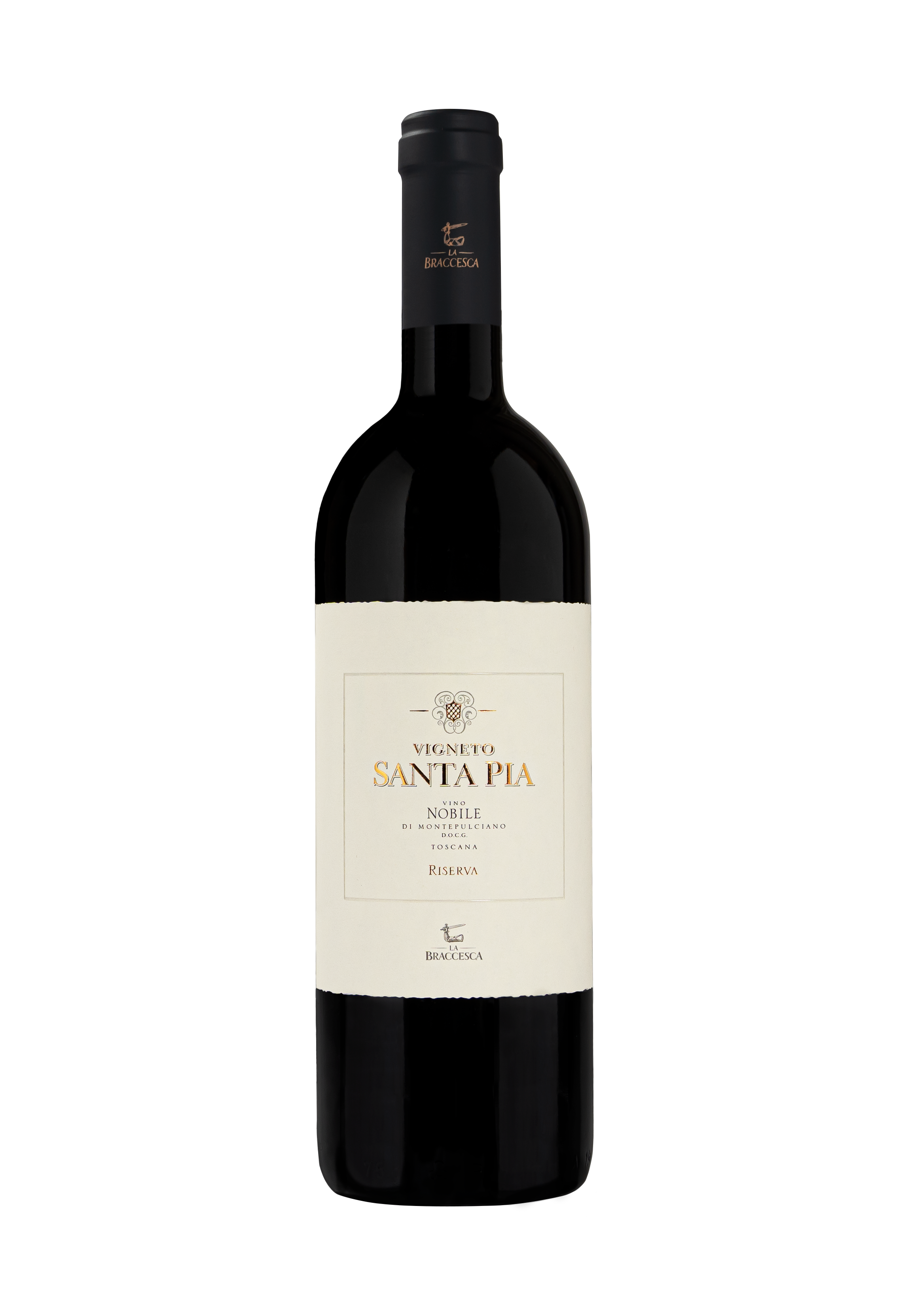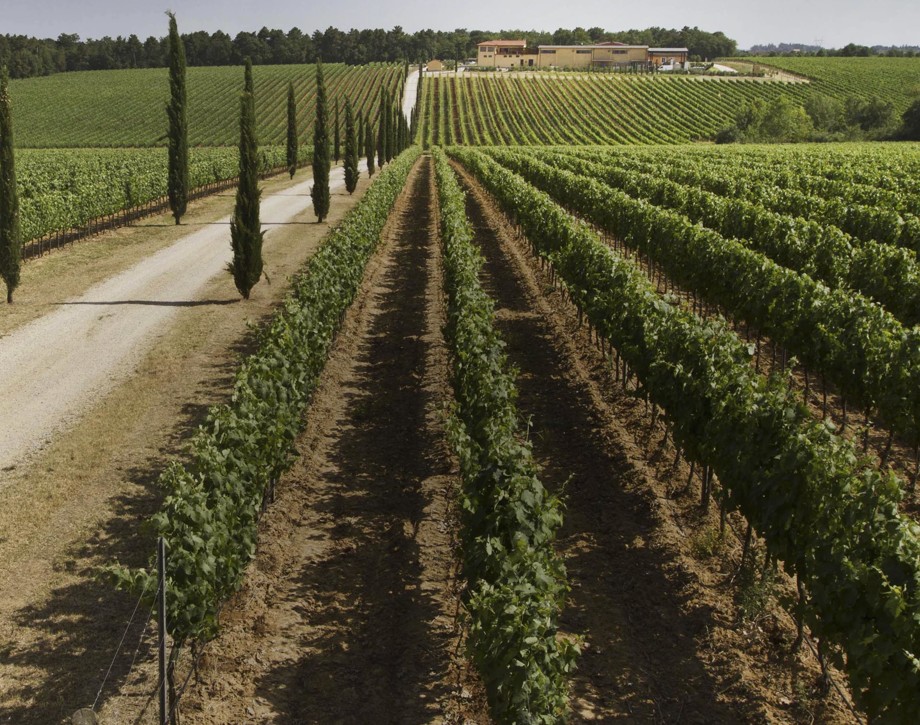Vigneto Santa Pia

Climate
The climate in the Montepulciano area in 2008 was characterized by an approximately ten day delay in vegetative development compared to recent vintages, but a balanced growing season eventually brought the grapes to a perfect state of ripeness. Frequent spring rains and low temperatures, below seasonal averages, led to an initial ten day delay in the ripening cycle of the vine. August was warm and dry, but temperatures dipped once again in early September, accentuating the delay which had accumulated during the previous phases of the season and slowing the final maturation of such late-maturing varieties as Prugnolo Gentile all the way up to the beginning of the harvest. In conclusion, the ripening of the grapes of the La Braccesca vineyards took place gradually and in a balanced way, thanks as well to higher temperatures during the second half of September and the first part of October, which further favored the achievement of healthy and ripe grapes.
Vinification
The grapes of the Santa Pia vineyard were selected twice in order to leave on the vine only the finest bunches for transformation into wine. The first, carried out in July (a bunch thinning in the vineyard) was aimed at lightening the load to ripen on the vine, the second to choose only the grape bunches which showed excellent ripeness. Picking then began and the grapes, once in the cellar, were delicately destemmed and pressed and the must fermented on its skins for approximately twenty days. The wine, at the end of its fermentation and maceration, went into 80 and 130 gallon barrels (tonneaux), where it went through a complete malolactic fermentation and then aged for a period of sixteen months. Then was bottled and aged in bottle for other 36 months before commercial release. This long aging period helped to smooth out tannin’s exuberance.
Historical Data
The La Braccesca estate covers some 1255 acres (508 hectares) where once were located the holdings of the Bracci counts, who gave their name both to the property and its count of arms: an armor-clad arm holding a sword. The overall vineyard surface consists of 850 acres (340 hectares) and is divided into two blocks: the first, 575 acres (233 hectares) is situated on the border between Montepulciano and the neighboring township of Cortona. The second, instead, 255 acres (103 hectares) insize, arrives close to the city itself and includes three highly renowned sub-zones for the production of outstanding red wine: Cervognano, Santa Pia, and Gracciano. Santa Pia is produced from a 37 acre (15 hectare) vineyard situated in the site of the same name, located the terraces below the town of Montepulciano. Its unique soil, medium in texture and consistence, rich in stones and sand, have assisted the ambition to produce an elegant, but at the same time classic, example of Sangiovese, one capable of transmitting the a highly recognizable expression of this historic production zone. The first year of production of Santa Pia was the 2001.
Tasting Notes
A wine of great impact, the 2008 Santa Pia is an intense ruby red in color, shows aromas of blackberries and red berry fruit along with well fused notes of tobacco and vanilla. On the palate the wine is soft and savory with an important tannic structure and a supple and elegant texture. The finish and aftertaste are long and caressing with mineral notes which are the distinguishing characteristic of the Prugnolo Gentile of Montepulciano.
Awards
Wine Spectator 92/100 USA

The Wine
Santa Pia is produced from a 15-hectare (37 acres) vineyard in an area called Santa Pia, located on the ridges just below the town of Montepulciano. This particular area has sandy loamy soils rich in rocky deposits known as “scheletro” that allow the Antinori’s to create an elegant yet traditional expression of the Sangiovese grape that reflects the characteristics of this historic winemaking area. The first vintage to be produced was 2001.

Climate
The climate in the Montepulciano area in 2008 was characterized by an approximately ten day delay in vegetative development compared to recent vintages, but a balanced growing season eventually brought the grapes to a perfect state of ripeness. Frequent spring rains and low temperatures, below seasonal averages, led to an initial ten day delay in the ripening cycle of the vine. August was warm and dry, but temperatures dipped once again in early September, accentuating the delay which had accumulated during the previous phases of the season and slowing the final maturation of such late-maturing varieties as Prugnolo Gentile all the way up to the beginning of the harvest. In conclusion, the ripening of the grapes of the La Braccesca vineyards took place gradually and in a balanced way, thanks as well to higher temperatures during the second half of September and the first part of October, which further favored the achievement of healthy and ripe grapes.
Vinification
The grapes of the Santa Pia vineyard were selected twice in order to leave on the vine only the finest bunches for transformation into wine. The first, carried out in July (a bunch thinning in the vineyard) was aimed at lightening the load to ripen on the vine, the second to choose only the grape bunches which showed excellent ripeness. Picking then began and the grapes, once in the cellar, were delicately destemmed and pressed and the must fermented on its skins for approximately twenty days. The wine, at the end of its fermentation and maceration, went into 80 and 130 gallon barrels (tonneaux), where it went through a complete malolactic fermentation and then aged for a period of sixteen months. Then was bottled and aged in bottle for other 36 months before commercial release. This long aging period helped to smooth out tannin’s exuberance.
Historical Data
The La Braccesca estate covers some 1255 acres (508 hectares) where once were located the holdings of the Bracci counts, who gave their name both to the property and its count of arms: an armor-clad arm holding a sword. The overall vineyard surface consists of 850 acres (340 hectares) and is divided into two blocks: the first, 575 acres (233 hectares) is situated on the border between Montepulciano and the neighboring township of Cortona. The second, instead, 255 acres (103 hectares) insize, arrives close to the city itself and includes three highly renowned sub-zones for the production of outstanding red wine: Cervognano, Santa Pia, and Gracciano. Santa Pia is produced from a 37 acre (15 hectare) vineyard situated in the site of the same name, located the terraces below the town of Montepulciano. Its unique soil, medium in texture and consistence, rich in stones and sand, have assisted the ambition to produce an elegant, but at the same time classic, example of Sangiovese, one capable of transmitting the a highly recognizable expression of this historic production zone. The first year of production of Santa Pia was the 2001.
Tasting Notes
A wine of great impact, the 2008 Santa Pia is an intense ruby red in color, shows aromas of blackberries and red berry fruit along with well fused notes of tobacco and vanilla. On the palate the wine is soft and savory with an important tannic structure and a supple and elegant texture. The finish and aftertaste are long and caressing with mineral notes which are the distinguishing characteristic of the Prugnolo Gentile of Montepulciano.
Awards
Wine Spectator 92/100 USA

Tenuta La Braccesca
The estate’s name comes from the historical farm that once stood there, owned by the Count of Bracci, whose coat of arms appears on the estate’s logo; an arm covered with armor brandishing a sword. Marchesi Antinori acquired the estate in 1990. The property extends over an area of 508 hectares (1255 acres) and the vineyards cover an area of 340 hectares (840 acres) divided into two blocks: the first is 366 hectares (904 acres) of which 237 (585 acres) are planted with vineyards and is located on the border between the cities of Montepulciano and Cortona. The other block is 142 hectares (350 acres) of which 103 (254 acres) are planted with vineyards, it extends all the way to Montepulciano encompassing three of the most famous parcels of land known for the production of great red wines: Cervognano, Santa Pia and Gracciano.

Soil
Sandy loam rich in very fine gravel.
















